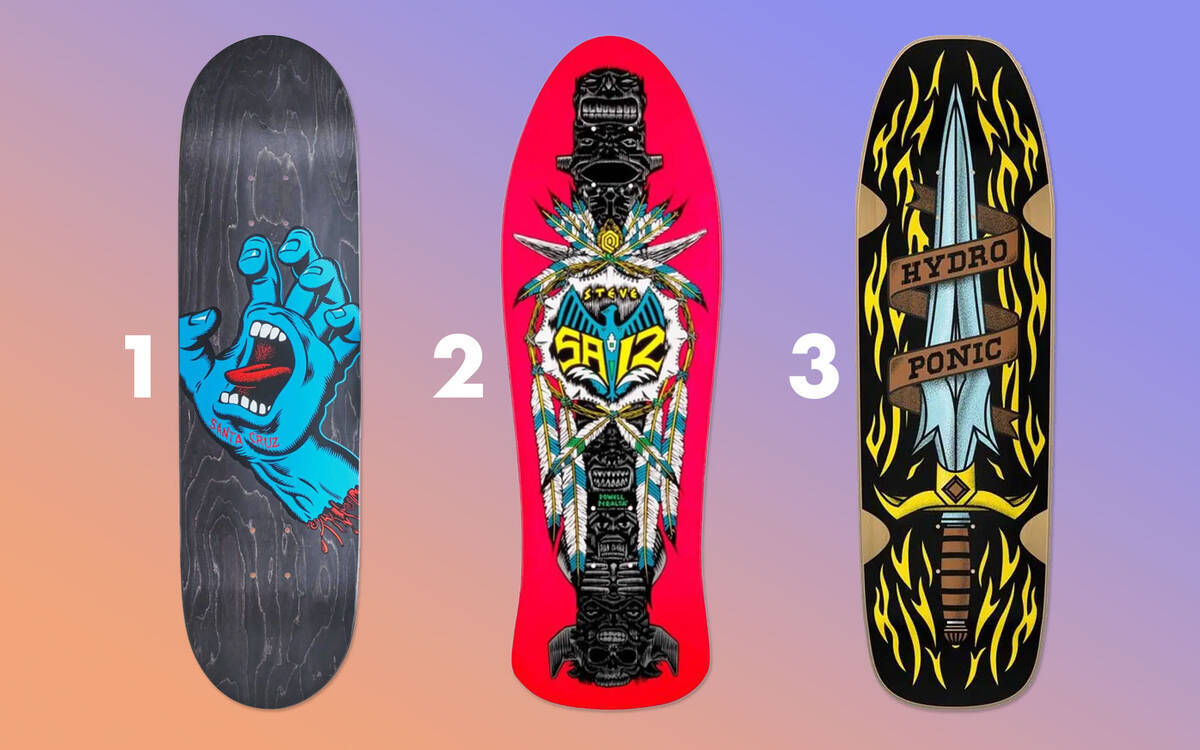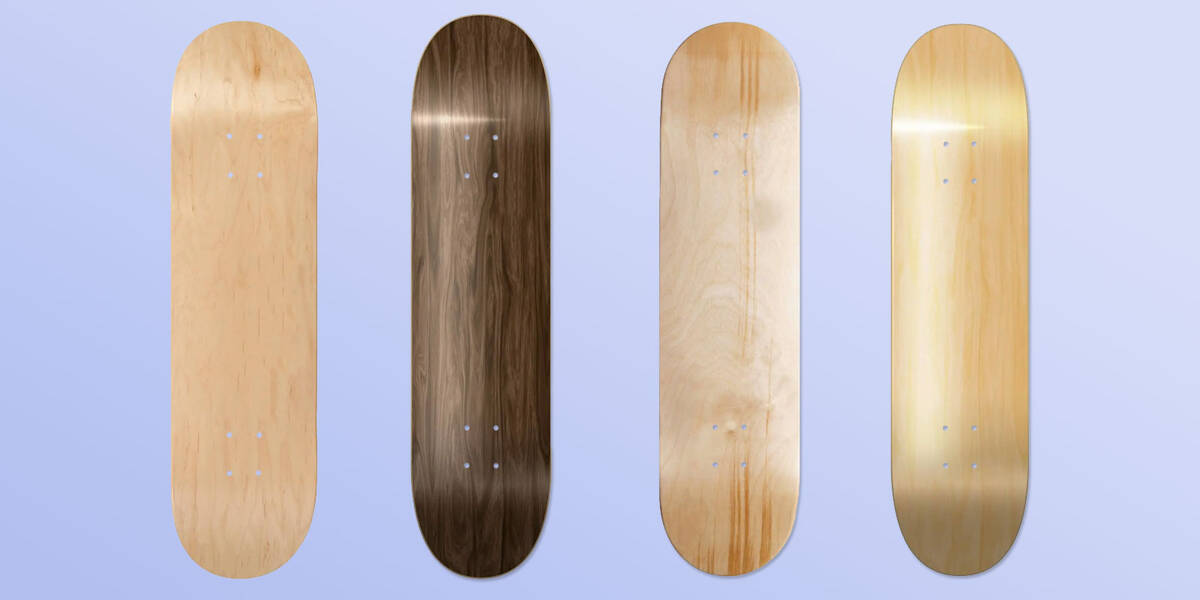Buying Advice for Skateboard Decks
Selecting the correct skateboard deck isn't complex science, yet it does demand consideration beyond just choosing the deck with captivating graphics. You might be curious about selecting the correct size for a skateboard deck, or which shape suits you best. And, what's the top choice of wood for a skateboard deck?
Whether you're seeking recommendations for novice skateboarders or you are an experienced skater on the hunt for a new deck, this guide aims to tackle any queries that might arise during your search for the ideal skateboard deck.
Overview
Determining Skateboard Deck Size: Getting the Dimensions Right
Your shoe size serves as a useful guide to determine the appropriate skateboard deck size. Essentially, a larger shoe size translates to a wider deck.
Your skateboarding style is crucial in deciding the deck width. Typically, vert and bowl skateboarding are better served by a broad deck, while a narrower one suits street skating and flip tricks. Consider the following:
- Broader decks: They offer more stability and ease in landing tricks due to a larger landing platform for your feet. Yet, increased width adds weight, implying more effort is needed to lift the skateboard off the ground and flip it.
- Narrow decks: These are more manoeuvrable and flip-friendly due to their lighter weight. Nonetheless, their smaller footprint makes catching the board post-flip a bit trickier, thus landing tricks might theoretically be slightly challenging.
Ultimately, your personal preferences dictate your choice, though consulting our skateboard size guide might provide insights into the optimal deck size relative to your shoe size.
ALIGNING DECK WIDTH WITH TRUCK WIDTH

For aligning skateboard decks with trucks, the general rule of thumb is this: Ensure the width of your skateboard deck aligns with the axle width of your skateboard trucks. Ideally, these widths should be identical, without a discrepancy larger than a quarter inch.
Ultimately, it’s your setup and personal preferences may vary, yet this serves as a guideline that many skaters consider.
SKATEBOARD LENGTH
Typically, not every skater worries about skateboard deck length as it generally correlates with width; wider decks tend to be longer and narrower decks shorter. Most skateboard decks range between 29” and 32” in length.
The length impacts the wheelbase and thus the stability of your setup. Additionally, consider your leg length: if you are short-legged, a shorter deck facilitates control, whereas long-legged individuals may find longer decks more manageable.
For those intrigued by longer skateboards, perhaps these resources might interest you:
Skateboard Deck Shapes: From Popsicles to Hybrids

1. Popsicle Shape 2. Old School Shape 3. Hybrid Shape
Nowadays, the popsicle shape is a staple for skateboard decks, but it’s merely one stage in the continuous evolution of deck design. The innovation of new deck designs evolves alongside the creativity of skateboarders constantly redefining boundaries.
POPSICLE SKATEBOARD DECKS
Popsicle decks adopt both a kick-tail and kick-nose, enabling skaters to pop tricks off either end. Its nearly symmetrical design broadened horizons for executing fakie tricks, nollies, nose slides, riding switch, and more. The evolution of popsicle skateboard decks coincides with the rise of street skating in the early ‘90s, as skaters innovated with flip tricks, slides, and grinds.
SHAPED SKATEBOARD DECKS
Trends in deck shapes evolve, and the popsicle is just a single variant among many. Hybrid decks blend the popsicle form with old-school shapes.
Certain skaters prefer egg-shaped decks, frequently surpassing 9 inches in width. These deviate from the parallel edges typical of a popsicle, adopting an oval shape that’s noted for combining the agility of popsicle decks and a substantial, stable standing area.
Plenty of retro-style decks are available. They can be used in bowls or for street cruising - their usage is entirely up to you! Explore our cruiser skateboard decks to find some attractive retro designs:
Understanding Skateboard Deck Concave

Concave features are central to modern decks, advancing with technical street skateboarding. The concave is the degree of the deck’s inflection from side to side. Skaters often find that concave decks facilitate trick flips by providing leverage, helping maintain foot placement, and lending rigidity. Skateboard deck concave usually falls into three categories: low, medium, and high:
- Low concave: Offers gentle curvature for a stable ride with a lowered centre of gravity.
- Medium concave: Enhances trick flipping and control. Opting for medium concave is a sound decision.
- High concave: Prominent curvature drastically influencing board agility and facilitating flips.
The concave shape affects your riding style, so it's worth pondering these aspects:
- The comfort and feel of the deck
- Trick leverage
- Deck rigidity and subsequently the pop
What Wood Types are Used for Skateboard Decks?

Maple wood dominates as the preferred material for skateboard decks, attributable to its strength, impact resistance, low weight, and flexibility.
Skateboard decks involve wooden layers glued or epoxied together during pressing. Typically, decks comprise 7 layers, hence the term 7-ply maple, signifying 7 veneers of maple. Maple wood is notably easy to shape, retaining its shape well post-molding, hence its popularity for skateboard construction.
Maple’s subvarieties present varying traits. For instance, Canadian maple is recognised as being 15% tougher than Chinese maple. This increased density comes from slow tree growth in colder climates, leading to denser growth rings than those formed in warmer locales.
For a deck that can endure heavy usage and retains pop and stiffness, opting for sturdier wood is recommended. Beginners might find differences in wood hardness negligible and instead prioritise affordability, finding ease in learning and being creative with a lower-quality deck.
Concluding Skateboard Deck Tips and Further Insights
Before purchasing a new skateboard deck, having some griptape handy is crucial. Browse our extensive selection here:
Discover more comprehensive information about skateboard components in this comprehensive guide:
If you're uncertain about applying griptape or other assembly-related details, refer to this guide:
Explore our collection of complete skateboards:
If you're looking to create a complete skateboard with your preferred components, we provide a practical tool for you:
